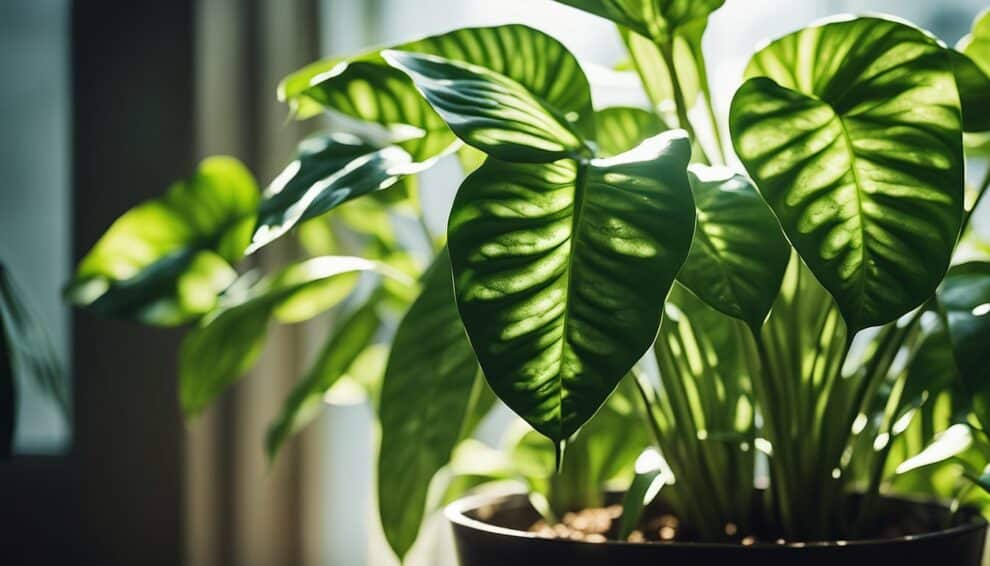Tropical plants are a popular choice for indoor gardening due to their lush foliage and exotic appearance. One such plant is the Dumb Cane (Dieffenbachia seguine), known for its large, variegated leaves that add a touch of the tropics to any space. However, many people are unsure about how to propagate this plant to expand their collection or share with friends.

Propagating Dumb Cane plants is a relatively simple process that can be done with stem cuttings. By taking a cutting from a healthy plant and following a few basic steps, it is possible to create new plants that will thrive in the same conditions as the parent plant. This guide will provide a step-by-step process for propagating Dumb Cane plants, including tips for caring for the new cuttings and ensuring their success. Whether you are a seasoned plant enthusiast or a beginner, this guide will help you expand your collection and enjoy the beauty of tropical foliage in your home.
Understanding Dieffenbachia Seguine
Species Overview
Dieffenbachia seguine, commonly known as Dumb Cane, is a tropical plant species of the Araceae family. It is native to Central and South America and is widely cultivated as an indoor plant due to its attractive foliage and easy maintenance.
Dumb Cane plants grow up to 5 feet tall and have large, oblong leaves that are green with white or yellow spots. The plant gets its common name from the toxic sap that can cause temporary speechlessness if ingested.
Growth Requirements
Dieffenbachia seguine prefers warm and humid conditions and grows best in well-draining soil with a pH range of 5.5 to 7.0. The plant requires bright, indirect light, but direct sunlight can scorch its leaves.
Dumb Cane plants need regular watering, but overwatering can lead to root rot. It is recommended to let the top inch of soil dry out before watering again. The plant also benefits from occasional fertilization with a balanced fertilizer.
Propagation of Dieffenbachia seguine can be done through stem cuttings or division of the mother plant. Stem cuttings should be taken from healthy, mature stems and rooted in a well-draining potting mix. Division of the mother plant should be done during the spring or summer months when the plant is actively growing.
Overall, Dieffenbachia seguine is a popular indoor plant that can thrive with proper care and maintenance.
Propagation Basics

Methods of Propagation
Dumb Cane plants can be propagated through stem cuttings or division. Stem cuttings are the most common method of propagation and can be taken at any time of the year. Cuttings should be taken from a healthy plant and should have at least two nodes. The cutting should be 6-8 inches long and should be taken from the top of the plant.
To propagate through stem cuttings, remove the lower leaves from the cutting and dip the cut end in rooting hormone. Plant the cutting in a pot filled with a well-draining potting mix and keep it in a warm and humid place. Keep the soil moist and wait for the roots to develop.
Division is another method of propagation that can be done when the plant has become too large for its pot. Gently remove the plant from its pot and separate the root ball into smaller sections. Each section should have at least one stem and a good root system. Plant each section in a pot filled with a well-draining potting mix and keep it in a warm and humid place.
Choosing Plant Material
When choosing plant material for propagation, it is important to select a healthy and disease-free plant. Look for a plant with strong stems, healthy leaves, and a good root system. Avoid plants that show signs of disease or insect infestation.
It is also important to choose a plant that is well-suited for the growing conditions in your area. Dumb Cane plants prefer bright, indirect light and well-draining soil. They also prefer warm and humid conditions. Make sure to choose a plant that is well-adapted to your growing conditions to ensure successful propagation.
Step-by-Step Propagation

Cutting and Rooting Process
To propagate Dumb Cane, the first step is to take a cutting from a healthy and mature plant. The cutting should be about 6 inches long and have at least two leaves. After cutting the stem, remove the lower leaves to expose the node where the roots will grow.
Next, dip the cut end of the stem in rooting hormone powder to encourage root growth. Then, place the stem in a container filled with moist potting soil. Cover the container with a plastic bag to create a greenhouse effect and keep the soil moist.
It will take about 2-3 weeks for the roots to grow. Once the roots have developed, remove the plastic bag and move the plant to a well-lit area, but avoid direct sunlight.
Potting and Aftercare
Once the roots have developed, it’s time to pot the new Dumb Cane plant. Choose a pot that is slightly larger than the root ball and fill it with a well-draining potting mix. Place the plant in the center of the pot and fill the remaining space with soil.
Water the plant thoroughly and place it in a well-lit area, but avoid direct sunlight. Keep the soil moist but not waterlogged, and avoid overwatering as it can lead to root rot.
To ensure the plant thrives, fertilize it every two weeks during the growing season with a balanced fertilizer. Prune the plant regularly to encourage bushier growth and remove any dead or yellowing leaves.
By following these simple steps, anyone can propagate Dumb Cane and enjoy the beauty of tropical foliage in their home or garden.
Common Challenges in Propagation

Pest and Disease Management
When propagating Dumb Cane, it is important to keep an eye out for pests and diseases that can harm the plant. Common pests that can affect Dumb Cane include mealybugs, spider mites, and scale insects. To prevent infestations, it is recommended to regularly inspect the plants and isolate any infected ones immediately.
Dumb Cane is also susceptible to fungal and bacterial diseases such as root rot, leaf spot, and stem rot. These diseases can be caused by overwatering, poor drainage, or a lack of proper air circulation. To prevent these diseases, it is recommended to use well-draining soil and avoid overwatering. In case of an infection, it is recommended to remove the infected parts of the plant and treat it with a fungicide or bactericide.
Troubleshooting Poor Growth
If the Dumb Cane plant is not growing as expected, there are a few things that could be causing the problem. One common issue is insufficient light. Dumb Cane requires bright, indirect light to thrive, so if the plant is not getting enough light, it may start to droop or turn yellow. In this case, it is recommended to move the plant to a brighter location.
Another common issue is overwatering. Dumb Cane prefers moist soil, but it is important not to overwater it as this can lead to root rot. To prevent overwatering, it is recommended to allow the soil to dry out slightly between waterings.
Finally, poor nutrition can also cause poor growth in Dumb Cane. It is recommended to fertilize the plant regularly with a balanced fertilizer to ensure it is getting the nutrients it needs to grow properly.
Frequently Asked Questions

What steps are involved in propagating Dumb Cane through stem cuttings?
Propagation of Dumb Cane can be done through stem cuttings. The first step is to select a healthy plant with a stem that is several inches long. Next, cut the stem at a 45-degree angle just below a node. Remove any leaves from the bottom of the stem and dip the cut end in rooting hormone. Finally, plant the cutting in a pot with well-draining soil and keep it moist until it roots.
Is it possible to root Dieffenbachia cuttings in water, and if so, how?
Yes, it is possible to root Dieffenbachia cuttings in water. Simply cut a stem at a 45-degree angle just below a node and place it in a jar or vase filled with water. Change the water every few days to prevent the growth of bacteria. Once roots have formed, transplant the cutting into soil.
What are the best practices for making a Dieffenbachia plant fuller and bushier?
To make a Dieffenbachia plant fuller and bushier, prune the stems regularly. This will encourage new growth and prevent the plant from becoming leggy. Additionally, ensure that the plant is receiving enough light and water, and fertilize it regularly.
How do you propagate Dieffenbachia in soil for optimal growth?
To propagate Dieffenbachia in soil, select a healthy stem and cut it just below a node. Remove any leaves from the bottom of the stem and dip the cut end in rooting hormone. Plant the cutting in a pot with well-draining soil and keep it moist until it roots. Once roots have formed, water the plant regularly and fertilize it every few weeks.
At what point on the Dieffenbachia plant should you make a cut for successful propagation?
To successfully propagate Dieffenbachia, make a cut just below a node on a healthy stem. This will ensure that the cutting has the potential to develop roots and grow into a new plant.
What is air layering, and how can it be used to propagate Dieffenbachia?
Air layering is a propagation technique that involves creating a small wound on a stem and then wrapping it in moist sphagnum moss. This will encourage the stem to develop roots, which can then be used to propagate the plant. To air layer a Dieffenbachia plant, select a healthy stem and make a small wound just below a node. Wrap the wound in moist sphagnum moss and cover it with plastic wrap. Once roots have formed, cut the stem below the roots and plant it in soil.













